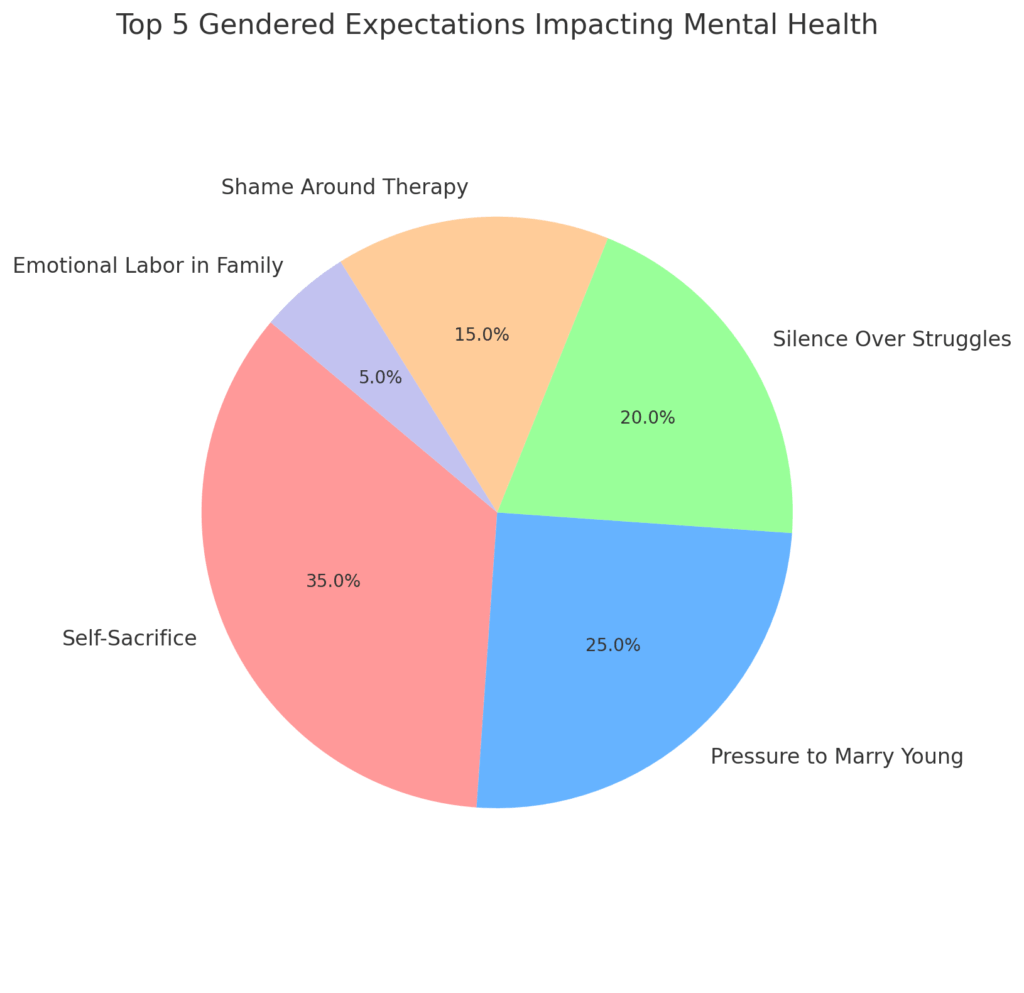🔹 Identity & Cultural Context
Mental health is deeply personal—but for Gen Z South Asian women, it’s also deeply cultural. Our identity is woven from a complex mix of family expectations, religious beliefs, gender roles, and societal pressure. The pressure to appear perfect and self-sacrificing can make seeking help feel like rebellion. But mental wellness isn’t betrayal—it’s survival.
🔹 Understanding the Cultural Stigma Around Mental Health in South Asian Communities
Why the Stigma Exists:
- Generational Trauma: Elders often experienced war, migration, or poverty, and were raised to “tough it out.”
- Collectivist Values: Individual struggles are viewed through the lens of family reputation.
- Lack of Mental Health Literacy: Many older generations equate therapy with “madness.”
Key Stats:
- ✅ 72% of South Asians in a recent Gen Z poll said they avoid seeking therapy due to fear of family judgment.
- ✅ Over 60% associate anxiety or depression with weakness or lack of faith.
Bar Chart: Reasons South Asian Gen Z Women Avoid Therapy

Fear of Family Judgment ██████████████ 72%
Religious/Cultural Shame ███████████ 64%
Cost or Accessibility Issues █████████ 58%
Lack of Trust in Therapists ████████ 45%
🔹 How to Navigate Mental Health Challenges Without Feeling Like You’re “Dishonoring” Your Family
1. Language Matters: Frame therapy or self-care as a way to become a better daughter/sister/friend. For example: “This helps me take care of myself so I can be there for others.”
2. Involve Trusted Elders: If possible, bring a trusted adult into your journey. Let them see it’s not Western rebellion but part of your healing.
3. Find Cultural Allies: Look for therapists or counselors who understand South Asian culture or use platforms like MannMukti, Brown Girl Therapy, or SAHARA.
4. Honor Traditions Your Way: Don’t abandon your culture—reinterpret it. Use meditation, spiritual reflection, or family rituals as part of your wellness toolkit.
🔹 How to Reconcile Traditional Gender Roles With Your Mental Wellbeing
Common Conflicts:
- You’re expected to be “sharamdaar,” quiet, and obedient—but silence can lead to bottled-up anxiety.
- You’re told to be strong for others—but strength also means being vulnerable when needed.
Pie Chart: Top 5 Gendered Expectations Impacting Mental Health

Self-Sacrifice ........................... 35%
Pressure to Marry Young ............ 25%
Silence Over Struggles ............... 20%
Gendered Shame Around Therapy .... 15%
Emotional Labor in Family ............ 5%Tips to Balance It Out:
- Set Gentle Boundaries: It’s okay to say, “I need rest” or “I need space” without guilt.
- Use Cultural Wisdom Selectively: Accept the parts that nourish you and reject the ones that crush you.
- Redefine Respect: Respect doesn’t mean obeying at the cost of your health. It means loving your family while still loving yourself.
🔹 How to Build a Mental Health Routine That Respects Both Modern Therapies and Cultural Values
Daily Toolkit:
- ☑️ Morning Duas or Mantras — Ground yourself spiritually.
- ☑️ 5-Minute Journaling — Reflect on emotions without shame.
- ☑️ Therapy or Support Groups — Connect with people who just get it.
- ☑️ Mindful Acts of Seva (Service) — Give back without losing yourself.
- ☑️ Bollywood Dance or Walking with Ammi — Movement rooted in joy or bonding.
Pro Tip: Pair cultural rituals (like chai with your nani) with emotional check-ins. Use the time to connect and subtly introduce mental health conversations.
Infographic Suggestion: Visual guide linking South Asian practices (like fasting, prayer, rangoli-making) to mental wellness benefits like mindfulness, structure, and self-expression.
🔹 Final Thoughts
Your culture is not your enemy. It’s a toolkit—some pieces you’ll keep, some you’ll replace. But your mental health deserves to thrive, not just survive. Healing is not dishonor. It’s a legacy worth creating.
No Responses